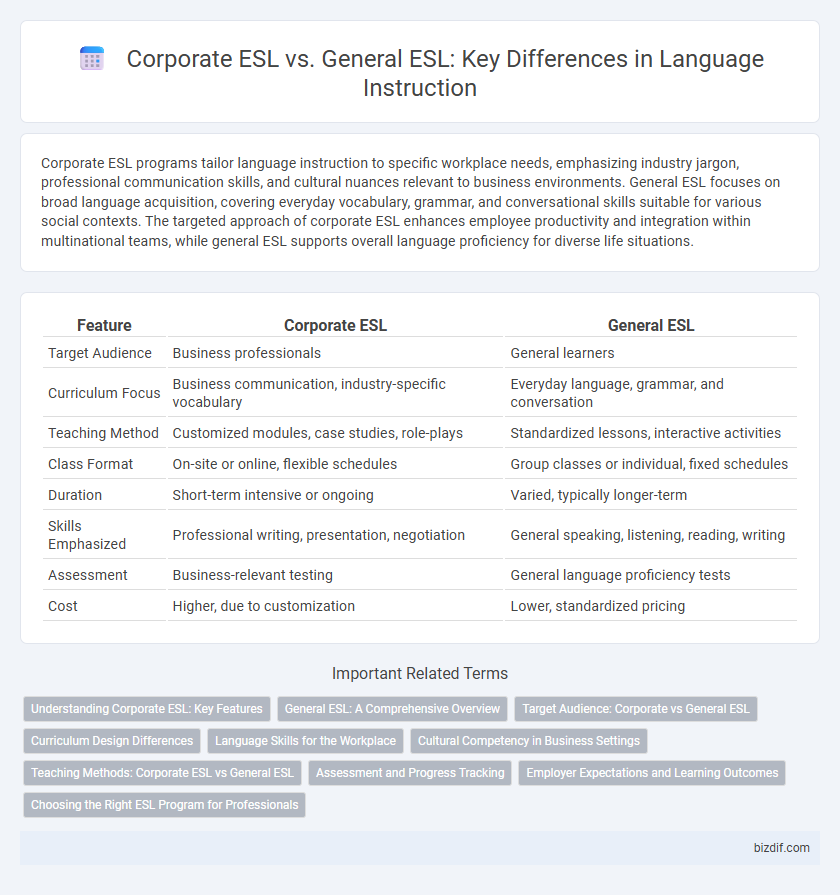Corporate ESL programs tailor language instruction to specific workplace needs, emphasizing industry jargon, professional communication skills, and cultural nuances relevant to business environments. General ESL focuses on broad language acquisition, covering everyday vocabulary, grammar, and conversational skills suitable for various social contexts. The targeted approach of corporate ESL enhances employee productivity and integration within multinational teams, while general ESL supports overall language proficiency for diverse life situations.
Table of Comparison
| Feature | Corporate ESL | General ESL |
|---|---|---|
| Target Audience | Business professionals | General learners |
| Curriculum Focus | Business communication, industry-specific vocabulary | Everyday language, grammar, and conversation |
| Teaching Method | Customized modules, case studies, role-plays | Standardized lessons, interactive activities |
| Class Format | On-site or online, flexible schedules | Group classes or individual, fixed schedules |
| Duration | Short-term intensive or ongoing | Varied, typically longer-term |
| Skills Emphasized | Professional writing, presentation, negotiation | General speaking, listening, reading, writing |
| Assessment | Business-relevant testing | General language proficiency tests |
| Cost | Higher, due to customization | Lower, standardized pricing |
Understanding Corporate ESL: Key Features
Corporate ESL programs emphasize industry-specific vocabulary, business communication skills, and workplace etiquette tailored to professional environments. These courses prioritize real-life corporate scenarios, such as meetings, presentations, and negotiations, enhancing practical language use for career advancement. Customization based on company needs and employee roles differentiates corporate ESL from general ESL, which covers broader language skills for everyday use.
General ESL: A Comprehensive Overview
General ESL programs provide foundational English language skills applicable across diverse settings, emphasizing reading, writing, speaking, and listening competencies. These courses cater to learners from various backgrounds, aiming to enhance everyday communication, academic proficiency, and cultural understanding. General ESL contrasts with Corporate ESL by targeting broader language acquisition rather than specialized workplace terminology or industry-specific language.
Target Audience: Corporate vs General ESL
Corporate ESL programs cater specifically to professionals aiming to improve business communication skills, focusing on industry-specific vocabulary, formal writing, and presentation abilities. These courses are designed for corporate employees who require proficiency in English to navigate workplace interactions, negotiations, and client relations. In contrast, general ESL targets a broader audience seeking everyday language skills for daily conversations, travel, or social integration.
Curriculum Design Differences
Corporate ESL curriculum design emphasizes industry-specific vocabulary, professional communication skills, and business etiquette tailored to sectors such as finance, technology, or healthcare. General ESL focuses on foundational language skills including grammar, everyday vocabulary, and conversational fluency for diverse real-life situations. Corporate ESL often incorporates case studies, role-playing, and scenario-based learning to enhance workplace relevance and learner engagement.
Language Skills for the Workplace
Corporate ESL programs target language skills essential for professional settings, emphasizing business communication, industry-specific vocabulary, and workplace etiquette. These courses develop proficiency in writing emails, conducting meetings, and presenting ideas clearly to enhance career advancement. In contrast, general ESL focuses broadly on conversational English and everyday language use, lacking the specialized training needed for workplace success.
Cultural Competency in Business Settings
Corporate ESL programs tailor language instruction to specific business contexts, emphasizing industry jargon and cross-cultural communication skills essential for professional environments. These courses integrate cultural competency training, enabling learners to navigate diverse workplace norms, communication styles, and etiquette critical for effective collaboration. In contrast, general ESL offers broader language skills without targeted business cultural nuances, often lacking the specialized focus required for international corporate success.
Teaching Methods: Corporate ESL vs General ESL
Corporate ESL programs emphasize immersive, industry-specific teaching methods that integrate business jargon, real-world scenarios, and role-playing tailored to professional environments. General ESL focuses on broad language skills through communicative techniques, grammar drills, and everyday vocabulary suitable for diverse social contexts. Instruction in Corporate ESL often utilizes case studies and task-based learning to enhance workplace communication, whereas General ESL employs interactive activities aimed at overall language competency.
Assessment and Progress Tracking
Corporate ESL programs utilize tailored assessment tools designed to measure language proficiency relevant to specific workplace tasks, enabling precise tracking of employee progress in professional communication skills. These programs often employ regular progress tracking systems integrated with business performance metrics to ensure tangible improvements aligned with company goals. General ESL courses focus on broader language competencies, using standardized assessments and periodic evaluations that track overall language development rather than specialized workplace applications.
Employer Expectations and Learning Outcomes
Corporate ESL programs emphasize industry-specific vocabulary and communication skills tailored to workplace scenarios, aligning with employer expectations for improved employee productivity and teamwork. These programs prioritize measurable learning outcomes such as enhanced professional interactions, effective email writing, and clear presentation delivery, differentiating them from general ESL courses that focus on broad language proficiency. Employers expect Corporate ESL to directly contribute to job performance, making its curriculum outcome-driven and goal-oriented compared to the more holistic approach of general ESL instruction.
Choosing the Right ESL Program for Professionals
Corporate ESL programs prioritize industry-specific vocabulary, workplace communication skills, and business culture, ensuring professionals gain practical language abilities tailored to their job roles. General ESL focuses on foundational language skills, such as grammar, reading, writing, and everyday conversation, suitable for broader language development. Selecting the right ESL program depends on the learner's career goals, immediate workplace needs, and desired language proficiency level in professional contexts.
Corporate ESL vs general ESL Infographic

 bizdif.com
bizdif.com